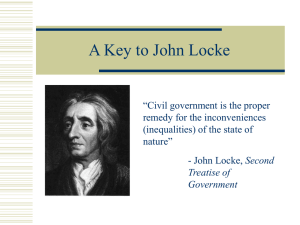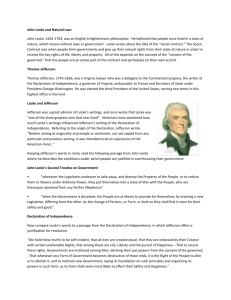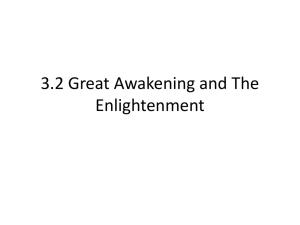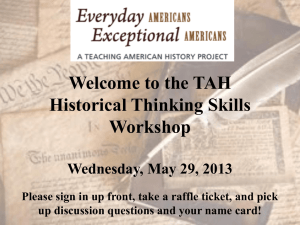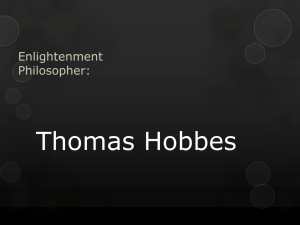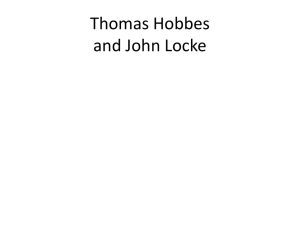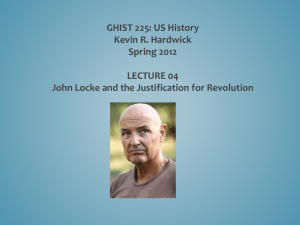Writing a research paper in philosophy
advertisement
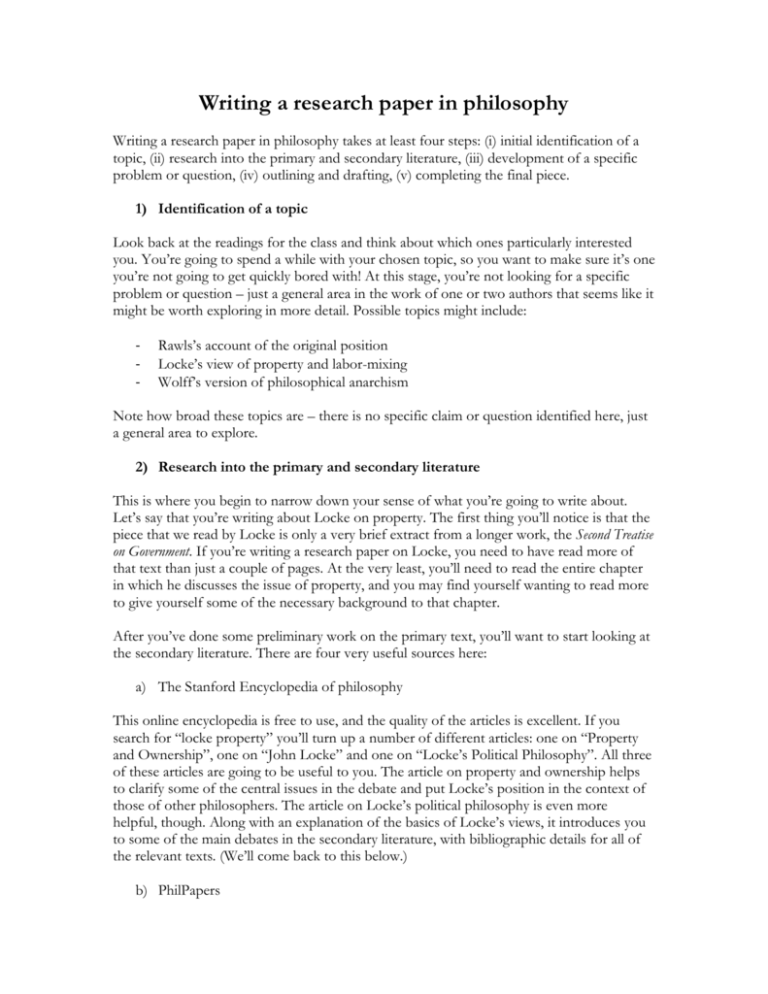
Writing a research paper in philosophy Writing a research paper in philosophy takes at least four steps: (i) initial identification of a topic, (ii) research into the primary and secondary literature, (iii) development of a specific problem or question, (iv) outlining and drafting, (v) completing the final piece. 1) Identification of a topic Look back at the readings for the class and think about which ones particularly interested you. You’re going to spend a while with your chosen topic, so you want to make sure it’s one you’re not going to get quickly bored with! At this stage, you’re not looking for a specific problem or question – just a general area in the work of one or two authors that seems like it might be worth exploring in more detail. Possible topics might include: - Rawls’s account of the original position Locke’s view of property and labor-mixing Wolff’s version of philosophical anarchism Note how broad these topics are – there is no specific claim or question identified here, just a general area to explore. 2) Research into the primary and secondary literature This is where you begin to narrow down your sense of what you’re going to write about. Let’s say that you’re writing about Locke on property. The first thing you’ll notice is that the piece that we read by Locke is only a very brief extract from a longer work, the Second Treatise on Government. If you’re writing a research paper on Locke, you need to have read more of that text than just a couple of pages. At the very least, you’ll need to read the entire chapter in which he discusses the issue of property, and you may find yourself wanting to read more to give yourself some of the necessary background to that chapter. After you’ve done some preliminary work on the primary text, you’ll want to start looking at the secondary literature. There are four very useful sources here: a) The Stanford Encyclopedia of philosophy This online encyclopedia is free to use, and the quality of the articles is excellent. If you search for “locke property” you’ll turn up a number of different articles: one on “Property and Ownership”, one on “John Locke” and one on “Locke’s Political Philosophy”. All three of these articles are going to be useful to you. The article on property and ownership helps to clarify some of the central issues in the debate and put Locke’s position in the context of those of other philosophers. The article on Locke’s political philosophy is even more helpful, though. Along with an explanation of the basics of Locke’s views, it introduces you to some of the main debates in the secondary literature, with bibliographic details for all of the relevant texts. (We’ll come back to this below.) b) PhilPapers This is an excellent resource that most professional philosophers use. It’s a free online database containing a good proportion of all of the philosophy that’s ever been published, in many cases with links to places you can get the content online. This is often a great place to look for articles that have been turned up on your SEP search, but it has a search engine that is often a good starting point in its own right. For our Locke project, there are only a few hits, mostly because a lot of the debate has taken place in books, but a couple of the articles here are still very useful. c) The Philosopher’s Index This has been around for longer than PhilPapers, and does pretty much the same kind of thing, but the results are sometimes different, so it’s often worth checking both. This is not available free online, but as long as you’re on the Sewanee network you can access it via the library. Go to Research Resources / Electronic Databases / Philosophy to access it. d) The library The Sewanee library can be useful to you in three main ways. First, for finding books that you turn up in your online searches. Often, these will be in the collection, but if they’re not, it’s possible to request an InterLibrary loan, which will generally get you pretty much anything you want as long as you allow a few days notice. Second, once you’ve found the place in the stacks where your author or topic is located, you can often find interesting things just by browsing the adjacent shelves – it’s an old-school method, but sometimes it works quite well. Third, the staff at the library are paid to help students like you with their research projects, and they will be delighted if you ask them to do this, so go ahead and ask! 3) Development of a specific problem or question If you make use of the resources above, you have a very good chance of discovering a good problem or question to address. Say that you were already interested in Robert Nozick’s famous “tomato juice in the ocean” criticism of Locke’s labor-mixing criterion. In the SEP article, you discover that James Tully responded to this objection on Locke’s behalf, arguing that Nozick had misunderstood Locke’s position. Reading further, you see that Jeremy Waldron criticized Tully’s interpretation of Locke, but Gopal Sreenivasan subsequently defended Tully. Now you’re beginning to develop a specific question, with a deep secondary literature. Does Nozick’s tomato juice objection rest on a misunderstanding of Locke’s position? In order to develop this question, you’ll need to go back to your primary and secondary texts to make sure that you’ve looked at the problem from all angles. First, you’ll probably want to get hold of the book from which the Nagel extract we read was taken – that’s Anarchy, State, and Utopia – and find the criticism of Locke in its context. Then you’ll want to look at the other secondary literature – Tully, Waldron, Sreenivasan, etc. – and build up a sense of the debate. Some of this reading might take you back to the primary texts. For example, Tully supports his argument by citing passages from Locke’s First Treatise on Government, so you’ll probably want to get hold of that and take a look at the sections he cites. One very important strategy to make use of at this stage of the project is following the footnotes. All serious academic books and articles make extensive use of footnotes and bibliographies to cite all of the works referenced in the text. By following up these footnotes, you can get the sense of a debate surprisingly quickly. One thing to note about the specific problem that we’re developing here is that it’s not quite as straightforward as the kind of problem you’d address in a shorter paper – e.g. is Locke’s account of labor-mixing a convincing one? For a research paper, your argument needs to be responsive to a debate in the secondary literature, and that often means it’s going to focus on a much narrower and more specific issue. Paradoxically, then, the thesis for which you argue in a research paper is actually likely to be more qualified and restricted than the thesis for which you would argue in a shorter paper. In our example, you may end up arguing that Nozick’s criticism does turn out to rest on a misunderstanding of Locke’s position. That doesn’t commit you to any view about whether Locke’s argument is successful overall – it just commits you to the view that this specific criticism by Nozick is not a viable one. What we’re really hoping for, however, is that this conclusion ends up telling us something interesting about Locke – for example, that the labor-mixing argument depends on premises or assumptions that aren’t really evident on a first reading. This is where writing a research paper can get really exciting – if it goes well, you actually end up shedding light on questions that wouldn’t have been clear at all if you hadn’t done all of that research! 4) Outlining and drafting Writing a 15-page paper can seem very daunting if you’re used to writing much shorter pieces of work. The key here is to realize that longer papers are always divided into sections. In our example, your initial plan might look something like this: i) ii) iii) iv) v) Introduction Locke’s account of labor-mixing and Nozick’s criticism Tully’s defense of Locke Debating Tully’s interpretation: Waldron and Sreenivasan Conclusion The introduction here should be less than a page, and the conclusion shouldn’t be more than two pages. That leaves about 12 pages left, so what you’re actually looking at is three sections of around 4 pages each. All of a sudden, that might not seem like much space! A lot of pages here are going to be taken up explaining the different positions and their relations to each other, so the amount of space that’s actually devoted to articulating your own view is relatively little. That space is extremely important, though – your argument is what is going to tie all of this material together into a coherent whole. This is where what you learned for writing shorter papers still applies: you need a clear thesis, good signposting language throughout, and constant reminders to the reader of where the argument is going. In a paper like this, it’s a very good idea to begin each section with a mini-introduction that reviews what has been done so far and introduces the points that will be made in the current section. People have different processes for outlining and drafting – the key thing is that you have to have some kind of process. I’m going to want to meet with you to discuss an outline and bibliography, which should include a statement of the question or problem that you’re addressing and the thesis for which you will argue, a list of the sections you are planning to have in your paper, a brief paragraph (or paragraph-length notes) summarizing each one, and a bibliography listing all of the primary and secondary sources that you have researched and plan to cite in the final piece. I also strongly recommend that you also meet with me at least a week in advance of the deadline to discuss a full draft of the paper. 5) Completing the final piece One very important thing to bear in mind about your final piece is that it should not necessarily include every single thing you’ve read and every single paragraph you’ve written. Most graduate students and professional philosophers will read a lot of chapters and articles that never make it into the final draft of their paper – you should expect some dead ends. Equally, it is quite normal for large chunks and even entire sections of your early drafts to be deleted entirely from the final piece. Very often, the only way to really figure out if an idea or argument makes sense is to start writing, and sometimes the only product of a couple of hours hard work at the keyboard is the realization that the argument you were trying to make just isn’t going to fly. This is always discouraging at the time, but it’s important to remind yourself that it’s an inevitable part of the process, and that none of the time you spend reading or writing is wasted, even if it didn’t result in anything that went into the final draft. (My own experience is that at least 60% of what I write ends up going in the trash can, and in many cases it’s probably more than that. One way to deal with the emotional cost of all that deletion is to keep a separate document open for you to cut and paste your deleted sections into – that means you’ll still have them if you change your mind, and even if you don’t, you’ll have some kind of tangible record of the work you put in.) The most important thing is that the final piece should read like a single, coherent line of thought, but there’s almost no chance of achieving that if you just sit down and expect all 15 pages to flow out just like that. One important aspect of completing a research paper is including a properly formatted bibliography and notes. I recommend that you use the Chicago Manual of Style, which can be accessed online for free through the Sewanee network, and which includes excellent guidelines and examples for exactly how to format notes and bibliographical entries for all kinds of different texts. I suggest that you try formatting your bibliography before we meet to discuss your outline, so that if you have any questions they can be dealt with then.

